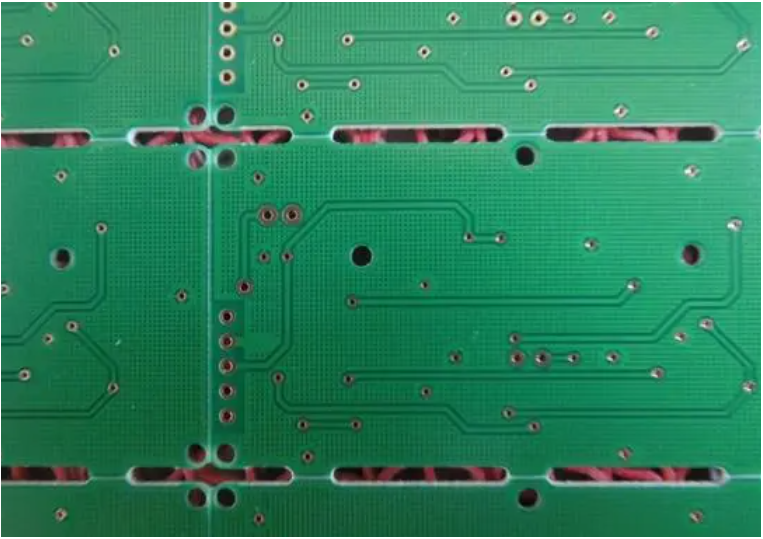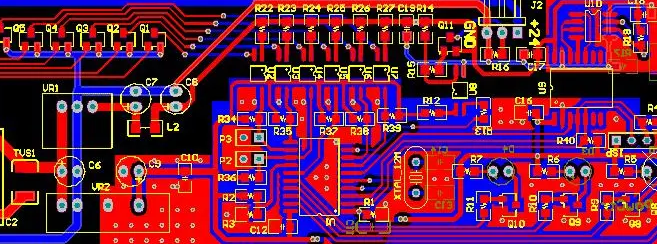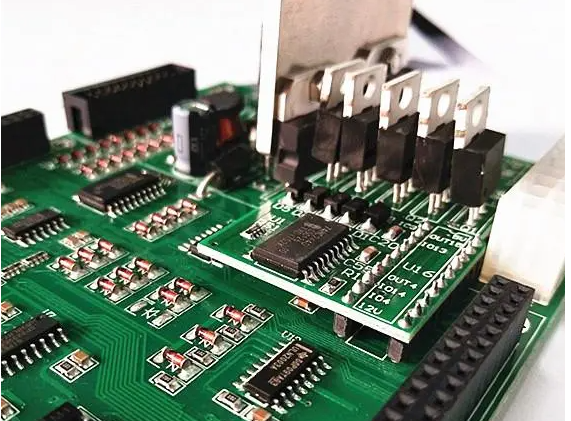
01
Q: What problems should we pay attention to when wiring high frequency signals?
A: Impedance matching of signal line; Space isolation from other signal lines; For digital high-frequency signals, the differential line will be better.
02
Q: When laying boards, if the lines are dense, there may be more holes, which will certainly affect the electrical performance of the board. How to improve the electrical performance of the board?
A: For low-frequency signals, vias do not matter. For high-frequency signals, vias should be minimized. If there are many lines, multi-layer boards can be considered.
03
Q: Is the more decoupling capacitors added to the board, the better?
A: The decoupling capacitor needs to add a proper value at a proper position. For example, the power supply port of the simulator needs to be added, and different capacitance values need to be used to filter out stray signals of different frequencies.

04
Q: What is the standard of a good board?
A: The layout is reasonable, the power redundancy of the power line is sufficient, and the high frequency impedance and low frequency wiring are simple.
05
Q: How much do through-hole and blind hole affect the difference of signals? What are the principles of application?
A: The use of blind holes or buried holes is an effective method to increase the density of multilayer boards, reduce the number of layers and the size of the board surface, and greatly reduce the number of plated through holes.
However, by comparison, through holes are easy to realize in technology and low in cost, so they are generally used in design.
06
Q: When it comes to analog digital hybrid systems, it is suggested that the electrical layer be divided, the ground plane be covered with copper, and it is also suggested that the electrical layer be divided, and different grounding points be connected at the power supply terminals, but the return path of the signal is far away. How to choose the appropriate method for specific applications?
A: If there are high frequency signal lines>20MHz, and the length and quantity are relatively large, at least two layers of analog high frequency signals are required. One layer of signal line, one layer of large area, and the signal line layer needs to make enough vias to the ground. The purpose is to:
For analog signals, this provides a complete transmission medium and impedance matching;
The ground plane isolates analog signals from other digital signals;
The ground loop is small enough, because you have punched many vias, and the ground is a large plane.
07
Q: In the circuit board, the signal input plug-in is on the left edge of the PCB and the MCU is on the right. In the layout, is it better to place the regulated power supply chip near the source connector (the power supply IC outputs 5V to the MCU through a long path), or to place the power supply IC to the right in the middle (the power supply IC outputs 5V to the MCU through a short line, but the input power supply line passes through a long PCB)? Or better layout?
A: First, is the signal input plug-in a simulator? If it is a simulator, it is recommended that the power supply layout should not affect the signal integrity of the analog part as much as possible. Therefore, there are several points to consider:
First of all, is the regulated power supply chip a clean and low ripple power supply? The power supply of the analog part requires high power supply;
Whether the analog part and MCU are the same power supply. In the design of high-precision circuit, it is recommended to separate the power supply of analog part and digital part;
The power supply for the digital part needs to consider minimizing the impact on the analog circuit.
08
Q: In the application of high-speed signal link, there are analog ground and digital ground for multiple ASIC, whether to use ground division or not? What are the existing guidelines? Which works better?
A: So far, there is no final conclusion. In general, you can refer to the chip manual. The manual of all ADI hybrid chips recommends a grounding scheme. Some recommend common grounding and some recommend isolated grounding, depending on the chip design.
09
Q: When should I consider the equality of lines? If equal length wire is considered, what is the maximum length difference between two signal wires? How to calculate?
A: Difference line calculation idea: if a sine signal is transmitted, the length difference is equal to half of its transmission wavelength, and the phase difference is 180 degrees, then the two signals are completely offset.
So the length difference is the maximum. By analogy, the difference between signal lines must be less than this value.
ten
Q: In which case is serpentine routing suitable for high-speed? Are there any shortcomings? For example, for differential routing, two groups of signals are required to be orthogonal.
A: Serpentine routing has different functions due to different applications:
If the serpentine wiring appears in the computer board, it mainly plays a role of filtering inductance and impedance matching, and is used to improve the anti-interference ability of the circuit. The serpentine wiring in the computer motherboard is mainly used in some clock signals, such as PCI-Clk, AGPCIK, IDE, DIMM, etc.
In general, PCB can be used as inductance coil of radio antenna in addition to filtering inductance. For example, 2.4G walkie talkies are used as inductors.
The wiring length of some signals must be strictly equal. The equal line length of high-speed digital PCB is to keep the delay difference of each signal within a range and ensure the validity of the data read by the system in the same cycle (when the delay difference exceeds one clock cycle, the data in the next cycle will be misread).
For example, there are 13 HUBLinks in the INTELHUB architecture. The frequency of 233MHz is used. They must be strictly equal in length to eliminate hidden dangers caused by time delay. Wire winding is the only solution.
Generally, the delay difference is required to be no more than 1/4 clock cycle. The delay difference per unit length is also fixed. The delay is related to the line width, line length, copper thickness, and board structure. However, if the line is too long, the distributed capacitance and inductance will be increased, and the signal quality will be reduced. Therefore, the clock IC pins are generally terminated, but the serpentine wiring does not act as an inductor.
On the contrary, inductance will make the higher harmonics in the rising edge of the signal phase shift, resulting in deterioration of the signal quality. Therefore, the serpentine line spacing is required to be at least twice the line width. The smaller the rise time of the signal, the more susceptible to the influence of distributed capacitance and distributed inductance.
Serpentine routing acts as a LC filter with distributed parameters in some special circuits.
eleven
Q: When designing PCB, how to consider EMC/EMI, and what specific aspects need to be considered? What measures are taken?
A: EMI/EMC design must consider the position of devices, PCB stack arrangement, important online routing, device selection, etc. at the beginning of layout.
For example, the position of the clock generator should not be close to the external connector as far as possible, the high-speed signal should go through the inner layer as far as possible and pay attention to the characteristic impedance matching and the continuity of the reference layer to reduce reflection, the slope rate of the signal pushed by the device should be as small as possible to reduce the high-frequency component, and when selecting the decoupling/bypass capacitor, pay attention to whether its frequency response meets the requirements to reduce the power layer noise.
In addition, note that the return path of high-frequency signal current makes the loop area as small as possible (that is, the loop impedance is as small as possible) to reduce radiation. The range of high-frequency noise can also be controlled by dividing the stratum.
Finally, properly select the chassis ground between PCB and housing.
twelve
Q: What should I pay attention to when designing the transmission line of RF broadband PCB? How to properly set the ground hole of the transmission line? Do you need to design the impedance matching by yourself or cooperate with the PCB manufacturer?
A: There are many factors to consider in this question. For example, various parameters of PCB material, transmission line model finally established according to these parameters, device parameters, etc. Impedance matching is generally designed according to the data provided by the manufacturer.
thirteen
Q: When analog circuit and digital circuit coexist, for example, half of them are FPGA or MCU digital circuit, and the other half is DAC and analog circuit of related amplifier. There are many power supplies with various voltage values. In case of power supplies with voltage values that are used by both digital and analog circuits, can we use the same power supply? What are the skills in wiring and magnetic bead layout?
A: It is generally not recommended to use this way. It will be more complex and difficult to debug.
fourteen
Q: When designing high-speed multilayer PCB, what is the main basis for selecting the packaging of resistor capacitor and other devices? Can you give some examples of commonly used packages.
A: 0402 is commonly used by mobile phones; 0603 is commonly used in general high-speed signal modules; The basis is that the smaller the package, the smaller the parasitic parameters. Of course, the same package from different manufacturers has great differences in high-frequency performance. It is recommended that you use high-frequency special components at key locations.
fifteen
Q: In general, in the design, the signal line or the ground wire should be taken first for the double panel?
A: This should be considered comprehensively. The routing shall be considered when the layout is considered first.
sixteen
Q: What should be paid attention to when designing high-speed multilayer PCB? Can you provide a detailed solution to the problem.
A: The most important thing to pay attention to is the design, which is how you divide the signal line, power line, ground line and control line in each layer.
The general principle is that the analog signal and analog signal ground shall at least have a separate layer. A separate layer is also recommended for power supply.
seventeen
Q: When do I use 2-layer boards, 4-layer boards and 6-layer boards? Are there strict technical restrictions (excluding volume reasons)? Is the frequency of the CPU or the frequency of its interaction with external device data?
A: The multilayer board can provide a complete ground plane at first, and can also provide more signal layers to facilitate wiring.
For applications where the CPU controls external memory devices, the interaction frequency should be considered. If the frequency is high, the complete ground plane must be guaranteed. In addition, the signal lines should be kept equal length.
eighteen
Q: How to analyze the impact of PCB wiring on analog signal transmission, and how to distinguish whether the noise introduced during signal transmission is caused by wiring or by operational amplifier devices?
A: This is difficult to distinguish, and only PCB wiring can be used to avoid the introduction of additional noise.
nineteen
Q: For high-speed multilayer PCB, what is the appropriate line width of power line, ground line and signal line, and what are the common settings? Can you give an example? For example, how to set the operating frequency at 300Mhz?
A: For 300MHz signal, impedance simulation must be done to calculate line width and distance between line and ground; The line width of the power line needs to be determined according to the size of the current. When mixing signal PCB, the ground is not represented by "line", but by the whole plane, so as to ensure the minimum circuit resistance, and there is a complete plane below the signal line.







